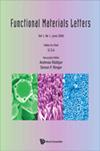碳纳米颗粒对Na2SO4·10H2O-Na2HPO4·12H2O相变材料循环稳定性和热性能的影响尺寸
IF 1.1
4区 材料科学
Q4 MATERIALS SCIENCE, MULTIDISCIPLINARY
引用次数: 0
摘要
本文章由计算机程序翻译,如有差异,请以英文原文为准。
Effect size of carbon micro-nanoparticles on cyclic stability and thermal performance of Na2SO4·10H2O-Na2HPO4·12H2O phase change materials
In this paper, carbon particles with micro-and nano-particle size were synthesized through a hydrothermal reaction of glucose, namely C-1(123.1 nm), C-2(229.2 nm), C-3(335.1 nm), C-4(456.2 nm) and C-5(534.0 nm) with distinct sizes. We utilized five size carbon particles as individual fillers into the EHS matrix materials to prepare composite eutectic phase change materials (C/EHS PCMs) by melt blending technique. The impact of carbon particle size on the dispersion stability and thermal properties of Na2SO4 · 10H2O-Na2HPO4 · 12H2O (EHS) phase change materials was investigated. It is shown that adding 0.2wt% C-2 can decrease the supercooling degree of EHS to 1.5 ?C. The cyclic stability of C/EHS varies significantly depending on the size of carbon particles. The results of differential scanning calorimetry reveal that the incorporation of C-1, C-2, C-3, and C-4 into EHS lead to an enhancement of latent heat. The latent heat capacity of EHS with 0.2wt% C-2 is 243.4 J*g-1, and after undergoing 500 cycles of solid-liquid phase transition, the latent heat remained above 200 J*g-1. The C-2/EHS composite phase change material holds significant potential for advancing building insulation and solar energy storage technologies.
求助全文
通过发布文献求助,成功后即可免费获取论文全文。
去求助
来源期刊

Functional Materials Letters
工程技术-材料科学:综合
CiteScore
2.40
自引率
7.70%
发文量
57
审稿时长
1.9 months
期刊介绍:
Functional Materials Letters is an international peer-reviewed scientific journal for original contributions to research on the synthesis, behavior and characterization of functional materials. The journal seeks to provide a rapid forum for the communication of novel research of high quality and with an interdisciplinary flavor. The journal is an ideal forum for communication amongst materials scientists and engineers, chemists and chemical engineers, and physicists in the dynamic fields associated with functional materials.
Functional materials are designed to make use of their natural or engineered functionalities to respond to changes in electrical and magnetic fields, physical and chemical environment, etc. These design considerations are fundamentally different to those relevant for structural materials and are the focus of this journal. Functional materials play an increasingly important role in the development of the field of materials science and engineering.
The scope of the journal covers theoretical and experimental studies of functional materials, characterization and new applications-related research on functional materials in macro-, micro- and nano-scale science and engineering. Among the topics covered are ferroelectric, multiferroic, ferromagnetic, magneto-optical, optoelectric, thermoelectric, energy conversion and energy storage, sustainable energy and shape memory materials.
 求助内容:
求助内容: 应助结果提醒方式:
应助结果提醒方式:


